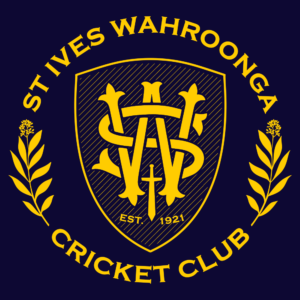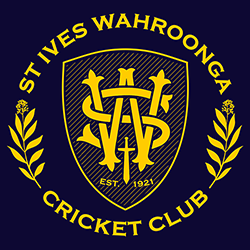37 Teams 7 Premierships
One of the most fascinating aspects of the research for this document involved, not only discovering who did what, when, and against whom, the match scores and possible records, but trying to imagine what it would be like to play cricket in an area such as Hornsby Ku-ring-gai district in the 1920s and 1930s. Imagine teams meeting at railway stations and travelling in buses along what would have been mainly dirt roads, through rural farmland and bush. Imagine trying to play cricket in the early 1940s when the world was at war. Imagine trying to play the game with the sort of equipment that was available at that time. Even at Test level in the 1920s, top batsmen were still wearing open slatted batting pads with no gloves which, when worn were nothing more than gardening gloves with rubber prongs sewn onto the fingers. Can you imagine today’s players having to go through the same ordeals in order to play a game of cricket?
Anyway, the St Ives Cricket Club was one of the founding clubs which formed the Hornsby District Cricket Association on March 11, 1926. However, it is believed that the Club played in the Northern Suburbs Cricket Association, fielding an “A” grade team on four occasions. In fact, cricket in this area had it’s origins dating earlier than the 1920s.
“For the last fifty years St Ives has had her cricket teams, consisting of players who could give a good account of themselves. The good old game is well to be upheld this season for St Ives has entered an “A” and “B” team in the newly formed Hornsby District Cricket Association to try and win the valuable Rofe Shield.”
The Advocate 24/9/1926
The Pymble News reported that the Club was playing in competitions as early as 1902. “The St Ives Cricket Club playing St Aubyns last Saturday got 135 runs to their opponents 2-34. The top scorers were W Caldwell 72 and W C O’Reilly 21.” The Pymble News 23/10/1902.
The first season of cricket in the Hornsby District Cricket Association saw only one grade being played, the A Grade. The St Ives Cricket Club soon found itself in the position to be able to field two teams, an A and B teams. During the early years the Association teams would frequently submit match reports to the local paper, “The Advocate”. It is from these reports that the earliest known complete scorecards for games involving either of the two St Ives teams have been discovered. The earliest ‘B’ team card is for a round 6 match and the earliest ‘A’ team card is for a round 11 match, both from the 1926/27 season. Reports for matches earlier in the season do exist but not in a form so as to formulate a scorecard.
In the first season in the HDCA there was only one grade of competition, the A grade. The B grade competition was introduced in 1927/28, the C grade in 1931/32 and the D grade in 1936/37. For the first ten years of competitions, the champions were declared on the principle of “first past the post”. After the first decade, a variety of methods were used to determine the structure of the competition and semi-final play-offs. It did not take long before the St Ives Club proved that it was one of the strongest in the Association.
After three years of playing very competitive cricket, the Club won it’s first premiership in the 1929/30 season, when it won not only the A grade title but the B grade as well.
In the early 1930s the St Ives Cricket Club had two coaches, both of whom represented Australia. Dr Perci Charlton toured England with the 1890 Australian team and played in two Test matches. The other coach was Dr Roy Minnett who played in nine Tests between 1911-12. In fact, Dr Perci Charlton was a well known figure in Sydney grade cricket for many years, both as a player and as an administrator. His efforts were such that he was made “Patron in Perpetuity” of the I Zingara Club.
During those first ten years of the Association, St Ives won the Rofe Shield [ the A Grade Premiership ] three times and were runners-up on two other occasions. This degree of success was not repeated again until the 1950s. Such has been the strength of the Club that throughout the period between 1926/27 and 1940/41 the Club was able to field more than one team in the Association’s competitions. The years when only one team was fielded are somewhat of a minority. Another indication of the Club’s strength is that it was the only foundation Club of the Association that survived the first ten years of Association competition. In fact, the Club survived until the end of the 1961/62 season, when it appears that the Club ceased to exist in the Association until it was reformed in time for the 1966/67 season.
The longevity and success of the Club can probably also be linked to the fact that the St Ives area had three of the better grounds in the Association. Cricket was played at Hassell Park, Bannockburn Oval and the St Ives Showground throughout the 1930s. Hassell Park, opened in 1921/22, was seen by the Association as one of the best grounds in use, so good in fact that nearly all A Grade finals were played there or just around the corner at Bannockburn Oval. The status of these grounds continued until Storey Park was constructed in 1953.
The importance of Hassell Park to the St Ives Cricket Club can be evidenced from an item in a November 1931 issue of the Hornsby Advocate.
“Hassell Park Oval will be the headquarters of the St Ives Cricket Club during the present season. Approval was granted to the last meeting of the Health and Parks Committee of Ku-ring-gai Council for the Club to use the grounds on Saturdays until 23rd April of next year, rent being fixed at £8. The Council reserves the right to use the Oval on any two Saturdays during that period on giving seven days notice.”
After the first decade of competition the first change to the playing conditions was made. All teams were placed in either A or C grades and a preliminary round of eight or so matches were played, after which both grades were split in two. The teams leading the two halves of A and C grades were declared the major winners and the teams leading the split were declared minor winners of B and D grades respectively. Thereafter, a second round of five or so matches was played within a four grade format. Following the completion of round two, the two teams with the highest aggregate in points from the two rounds of competition played a Final to an outright conclusion, unless a preliminary winner, major or minor, had also scored the most points in it’s grade in the second round of matches and would declared grade champion in it’s own right. The Final, played to an outright conclusion meant that occasionally a grade champion took several weekends to be declared and some high scores being achieved. Unfortunately, full scorecards of this era appear not to have survived as they would make interesting reading for today’s cricketers.
It is quite likely that if it wasn’t for the efforts of Jim Maunder there would not have been a St Ives Cricket Club in these early years. Jim was President of the Club for many years and was Vice-Patron and Patron of the Association and in 1935, Jim was made a Life-Member of the Association.
In 1936 he donated the J G Maunder Shield [long since lost] for the Schoolboy Competition. His two sons, Jack and Doug, were playing members of the St Ives Cricket Club in the late 1920s and into the 1930s. In the 1927/28 season Doug took 42 wickets at an average of 13.86 playing in A Grade and followed that in 1928/29 with 46 wickets at 17.56, also in the A Grade competition. Jack scored 554 runs at 29.15 in 1928/29 playing in the A Grade ranks and followed that up with 401 runs at 25.06 in 1931/32, again in the A Grade competition. Both Jack and Doug followed in their father’s footsteps to hold positions on the Association’s executive.
Doug was Secretary of the Association in 1928/29 and 1931/32, Senior Vice-President in 1935/36 and between the years of 1946 and 1951, Vice-President between 1933 and 1935 and again between 1941 and 1946. He was also the Association’s Delegate to the New South Wales Junior Cricket Union between 1931 and 1933.
Jack, was likewise distinguished, being the Association’s Delegate to the New South Wales Junior Cricket Union in 1930/31 and Senior Vice-President of the Association through the years from 1936 to 1938.
Under the circumstances, it certainly appears a little strange that Doug, in particular, was never made a Life-Member of the Association, especially when you consider the number of tasks that he undertook over the span of twenty-three years. It is not known what positions, if any [ although that seems unlikely ], that either of the two held at Club level.
Other leading St Ives players of the period 1926 to 1941 included;
R Veitch: who was regarded as on of the better players in the Hornsby District Cricket Association in the late 1920s.
F Horsey: a hard hitting top order batsman who hit 1691 runs at an average of around 36 in three seasons from 1929 to 1932, all in A Grade.
G Knight: who took 65 wickets at 8.3 in 1926/27 and 41 wickets at 7.5 in B Grade the following season.
A Taylor: in 1928/29 scored 633 runs at 24.03 and took 37 wickets at 12.8 playing B Grade to become one of the Club’s first true all-rounders.
R Reilly: in three seasons, 1930 to 1933, took 153 wickets at around 8.10. His 1930/31 bowling average of 5.34, taking 60 wickets along the way, still stands today as the best ever B Grade bowling average in the Hornsby District Cricket Association.
E Bartley: who in 1931/32 scored 537 runs at 33.5 in A Grade. In the seasons 1934/35, 1935/36 and 1936/37 he took a total of 143 wickets at an average of around 11.0 and in 1940/41 took another 40 wickets at 11.3, all in A Grade.
J Murray: in the seasons 1928/29, 1933/34, 1935/36 and 1936/37 hit 1520 runs at an average of around 27.0, mainly playing in A Grade.
A Knight: who in the seasons 1937/38, 1938/1939 and 1939/40 took 118 wickets at an average of around 12.1. In 1937/38 he combined his 30 wickets at 9.9 with 405 runs at a average of 20.20.



